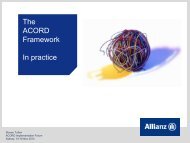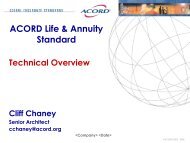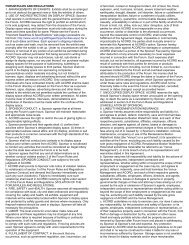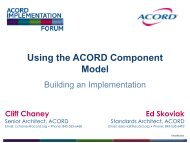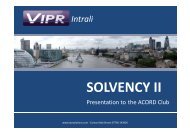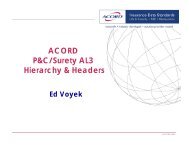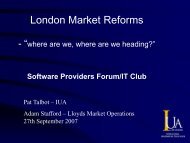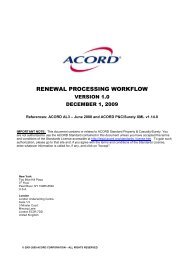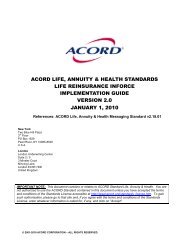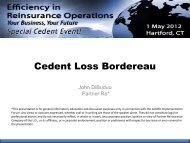Information Model - Acord
Information Model - Acord
Information Model - Acord
- No tags were found...
You also want an ePaper? Increase the reach of your titles
YUMPU automatically turns print PDFs into web optimized ePapers that Google loves.
The ACORD FrameworkAn Insurance EnterpriseArchitecture
ACORD built the Frameworkfor greaterefficiency• Need for a singledata model• Framework provides a foundation for standardscreation and development• Framework creates a base for model drivendevelopment and maintenance of standards• Framework better serves ACORD members andthe entire insurance industry
Facets of theACORD FrameworkGlossary of terms usedby all other facets of theFrameworkThe relationshipsamong insuranceconceptsWhat insurancecompanies doLogical persistencemodel based on the<strong>Information</strong> <strong>Model</strong>Common interfaces andservices definitions forinsurance systems
The Business Glossary containscommon insurance definitions• Non-technical definitions• Single business glossary tobridge communication gaps• Generated from <strong>Information</strong>and Capability <strong>Model</strong>s
Questions?
The Capability <strong>Model</strong> defineswhat insurance companies do• Standard definitions for a company’scapabilities/business activities• Does not define an ordered workflow• The <strong>Model</strong> offers a functional decomposition• Tied to Component <strong>Model</strong> service operationsSpreadsheet FormatUML Format
Capability <strong>Model</strong> includesProcess MapsClaims• Capability• ClaimsClaims LifecycleManagementClaimsHandling• Sub Capability:• Claims Lifecycle Management• Sub-sub Capability• Claims Handling• Activity / Process:InvestigateClaim• Investigate Claim
ProcessMapsCapability<strong>Model</strong>The Capability <strong>Model</strong>Top Level Capabilities• Business Management• Channel Management• Contract Administration• Customer Service• Enterprise Services• Claims• Finance• Marketing• Product• Sales
Common Capability <strong>Model</strong> Uses Business Process <strong>Model</strong>ing Capabilities and business activities provide thebuilding blocks for business process automation Delivered in UML for ease of porting into BPM tooling Business Activity Reference <strong>Model</strong> A common model set of definitions that can beagreed upon across the industry Celent used the Capability <strong>Model</strong> as the base for theBPO questionnaire and report for 2011
Questions?
The <strong>Information</strong> <strong>Model</strong> organizes andrelates insurance concepts
ACORD <strong>Information</strong> <strong>Model</strong>• Alignment in Core Concepts• Activity• Party• Physical Object• Agreement• Product Specification• Etc…130+ Packages, 900+ Classes, 2000+ DataElements• Formal naming and design patternssimilar to data/messagingstandards• Framework better serves ACORDmembers and the entire insuranceindustry
Common <strong>Information</strong> <strong>Model</strong> Uses Enterprise Reference <strong>Model</strong> Logical organization of like concepts Standard baseline for how concepts inter-relate Business focused Bridge between business and technical Canonical <strong>Model</strong> A common model for data interoperability, twosystems that refer to the concept of an Agreement butname them differently (Contract versus Policy) Single source of data organization Needed for semantic integration
The Semantic Hub ConnectsMessages and Technology• <strong>Information</strong> <strong>Model</strong> isthe common bridge• Enables any-to-anyintegrationACORDLife, Annuity &Health StandardsACORDP&C/SuretyStandardsACORDReinsurance & LargeCommercialStandards• Single source ofmeaning –<strong>Information</strong> <strong>Model</strong>OperationalData Store<strong>Information</strong><strong>Model</strong>PolicyAdministrationSystemDataWarehouseData <strong>Model</strong>ClaimsSystem
ACORD Translator ViewVocabularyUsing mappings between data standards andthe <strong>Information</strong> <strong>Model</strong> to facilitate standardto standard migrations and transformationsImportantcharacteristics:• Transformationfunction allowsfor pre-fill ofcommon contentACORDTranslator“Black Box”TransformationFunctionData StandardA<strong>Information</strong> <strong>Model</strong>VocabularyData StandardB• Migrationfunction replacesdeprecatedcontent withupdated locationmodelingACORDTranslator“Black Box”MigrationFunctionData AVers 1.21Migration EngineData AVers 1.25
MDMI View – Semantic IntegrationVocabulary• Expressing mappings between datainterfaces in an industry standardformat – OMG’s MDMI SpecificationMDMIDesignerData InterfaceA<strong>Information</strong> <strong>Model</strong>VocabularyData InterfaceBImportant characteristics:• Ease-of-use – map datainterfaces to a flatvocabulary• Portability – use anyMDMI run-timeOMG MDMI Standard FormatMDMIRun-timeDataAData BMDMI Engine
Questions?
The Data <strong>Model</strong>: Same content,different format•Turns <strong>Information</strong> <strong>Model</strong> into format used fordata persistence design and implementation•Logical level model not physical model•Used in any database implementation•Does not consider data optimizationtechniques•Makes no assumptions on behalf ofmembership
Same Content, Different Format
Same Content, Different Format
Same Content, Different FormatPrimary KeyNamingConventionsForeign KeyDiscriminator
Questions?
A standardized Component <strong>Model</strong> providesa baseline for plug and play softwaredevelopmentClaimsCustomer PortalAgency SystemPolicyAdministrationBillingInternal SystemCRM
Component <strong>Model</strong> : Create systems usingdifferent component combinationsimplementing common interfaces andservice definitions=Claim System(Built or Bought)
Capabilities Are Basis ofProcess Components
Processes Align to Services
Services Define Service Operations
Inputs & Outputs Expressedin <strong>Information</strong> <strong>Model</strong>
Three Types of ComponentsProcess Components aligndirectly to the businessprocess models (processesand activities)Infrastructure Componentsare bound to a specificenvironment and provide thetechnical services that everyapplication needs.Phase I– 1Q2013<strong>Information</strong> Componentsprovide direct manipulationof the underlying<strong>Information</strong> <strong>Model</strong> classes.Phase III
ACORD Framework: Status OverviewYear‐Month Framework Facet Release2008 Glossary (Initial Donation IBM) v1.02012 Glossary (New Tooling) V2.02007 Capability <strong>Model</strong> (Initial Donation IBM) v1.02009‐11 Capability <strong>Model</strong> (Donation Deloitte) v2.02011 Capability <strong>Model</strong> (New Content Donation(s)) v2.12009‐09 <strong>Information</strong> <strong>Model</strong> (Initial Donation Prima) v1.02010‐04 <strong>Information</strong> <strong>Model</strong> (Working Group Refinements) v1.22011‐05 <strong>Information</strong> <strong>Model</strong> (Donation IBM) v2.02011 ‐ 2012 <strong>Information</strong> <strong>Model</strong> ‐ Standards Mappingsv2.x(Incremental Releases –2.3 Current)2009‐11 Data <strong>Model</strong> (Hand Created) v1.x2012 Data <strong>Model</strong> – Fully Generated v2.x2012 Component <strong>Model</strong> ‐ Initial Release v1.0
Questions?
Framework ResourcesSupport: framework@acord.orgShane McCulloughChief Enterprise Architect, ACORDEmail: smccullough@acord.org • Phone: +1 (845) 535-6482Cliff ChaneySenior Architect, ACORDEmail: cchaney@acord.org • Phone: +1 (845) 535-6468Mark OrlandiSenior Business Analyst, ACORDEmail: morlandi@acord.org • Phone: +1 (845) 535-6478
London Underwriting CentreSuite 1/33 Minster CourtMincing LaneLondon EC3R 7DDUnited Kingdom+44 (0)20 7617 6400Two Blue Hill Plaza3 rd FloorPearl River, NY 10965USA+1 845 620 1700



